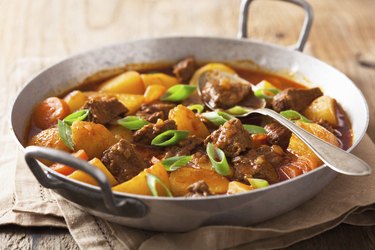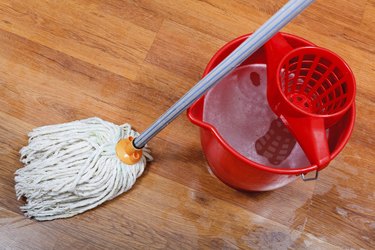
Fat boosts flavor in soups, stews and sauces, but the fatty ingredients can result in too much fat that should be removed to make the dish as tasty as possible. Grease is more viscous than water, so it collects at the surface of the dish. Several options allow you to absorb the excess grease from the surface while limiting the amount of water or other liquids absorbed.
Lettuce Leaf
Video of the Day

A few lettuce leaves can absorb most of the grease from the surface of soups and other dishes. Iceberg lettuce and other lettuces with large, relatively flat leaves work well. Turn off the heat to the pan and stop stirring, allowing several minutes for the grease to separate and rise to the surface. Pull off a few lettuce leaves and place them gently on the surface -- avoid breaking the surface tension on the grease so the lettuce doesn't fall through to the water or other liquid. The color deepens as the leaves absorb the grease. Remove the leaves after about 5 minutes or when the leaves are noticeably full of grease. Wait a few minutes for the grease and liquid to settle. Repeat the process with more lettuce leaves until most of the grease is absorbed.
Video of the Day
Bread Slice

Bread is often used to sop up extra sauce or gravy from a plate or bowl, and can be just as effective at absorbing excess grease while cooking. The bread will also readily absorb other liquids in the dish, so you must use caution to avoid breaking through the grease layer. Remove the crust from the bread, revealing more of the porous bread interior. Brush the bread lightly over the surface of the dish, moving slowly to allow the grease to absorb into the bread. Turn the bread over as needed to reveal a fresh section to absorb more grease. Discard the bread before it is full and begins to fall apart, using a new piece of bread until most of the liquid is absorbed.
Grease Mop

These specialty kitchen tools are designed specifically for remedying excess grease while cooking. There are several different versions of this product, but all generally feature a short handle with a series of long fibers at the end, like a small version of a rag mop. Hold the grease mop upright with the fibers barely touching the grease. Swirl it around the surface of the dish while the grease is wicked up into the fibers. Some grease mops have a telescoping tube connected to the handle that you can slide down the fibers to squeeze out the grease for disposal. Grease mops can be cleaned with dish detergent and reused, but they lose efficacy over time.
Paper Towel

Absent any other grease absorbing options, you might find luck with a paper towel or even a piece of tissue paper. Lay the paper flat on top of the grease and it will quickly absorb the grease. Discard the first paper and repeat with a clean piece, repeating this process until most of the grease is absorbed. This option can be messy if the grease drips over your counter as you attempt to dispose of it. Another similar option is to wrap a paper towel around a few ice cubes. Gather the edges of the towel above the ice and twist to make a handle. Drag the paper-covered ice cubes across the grease. The paper towel absorbs the grease and the ice cools it rapidly so it clings to the paper towel in hardened chunks that won't make a dripping mess of your kitchen.